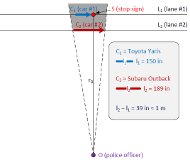4/23/2012
Scientific Paper Demonstrates Faulty Stop Sign TicketPolice observations can be incorrect when issuing a stop sign ticket.

Police may issue a ticket for rolling through a stop sign, even when a motorist has done nothing wrong, according to a paper by a research scientist at the University of California, San Diego. Dmitri Krioukov was found not guilty earlier this month by a Superior Court traffic commissioner based on the evidence provided in a detailed written analysis of the incident entitled "The Proof of Innocence."
"Police officer O made a mistake, confusing the real spacetime trajectory of car C which moved at approximately constant linear deceleration, came to a complete stop at the stop sign, and then started moving again with the same acceleration," Krioukov wrote in his paper. "As a result of this unfortunate coincidence, the [police officer's] perception of reality did not properly reflect reality."
The proof worked because three specific conditions were fulfilled in his case. The police officer was watching from a distance as a car decelerated. Something then temporarily blocked his view, then the observed car accelerated again. Krioukov argued that the observer did not perceive the car's actual speed, but rather its angular velocity. He compared it to a train moving at a constant speed that looks like it is traveling faster as it approaches nearer to the observer.
The relation of the actual linear speed to the observed angular velocity can be determined through geometry. Krioukov gave the example of an officer 33 feet from a stop sign observing his Toyota Yaris traveling at 22 MPH. The officer's view is temporarily obstructed by a Subaru Outback in the lane closer to the officer. Krioukov also said he had a bad cold that day and braked very hard at the sign. While the officer's view was obstructed, the officer would have interpolated what the unseen movement would have been. Thus, the officer concluded the Yaris would have been doing about 18 MPH in a straight line. This is not what happened, as the car's actual velocity at the moment was 0 MPH.
Krioukov admitted the officer's mistake was natural since he was using his vision to estimate speed, not a radar or laser gun.
"The paper was awarded a special prize of $400 that the author did not have to pay to the state of California," Krioukov wrote in the abstract for his paper.
A copy of the paper is available in a 430k PDF file at the source link below.


